Space opera is hard to do well. And it’s hard to think of a better space opera than the ’50s classic Forbidden Planet. It’s also hard to think of a more ’50s movie, which is probably the reason it works so well even to this day.
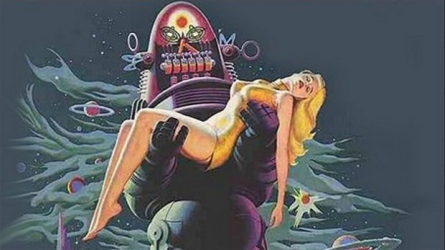
AMAZING! (Scene not actually in film.)
The year is 2200AD (I think). A few short years after landing on the moon (around 2090!), man has colonized all of the local worlds and has begun to colonize other worlds. Our story begins as the starship Bellerephon is approaching Altair IV. Their mission? To find out what’s going on with a colony sent nearly 20 years earlier. But as they approach, they’re warned off by an ominous disembodied Walter Pidgeon, forbidding them to come to the planet. (And that’s how you get a title, people.)
Captain Leslie (“don’t call me Shirley”) Nielsen in an early screen role and his crew, “eighteen competitively selected super-perfect physical specimens with an average age of 24.6 who have been locked up in hyperspace for 378 days” land on the planet anyway (or we ain’t got a pitcher!) and discover grumpy old Dr. Morbius (Pidgeon), the sole survivor of the colony. Everyone else, he says, was literally torn to shreds by some force that he and his wife were apparently immune to.
His wife died of natural causes, so if you would please be so kind as to depart the planet immediately before you discover his ridiculous hot and naive daughter that’d be…
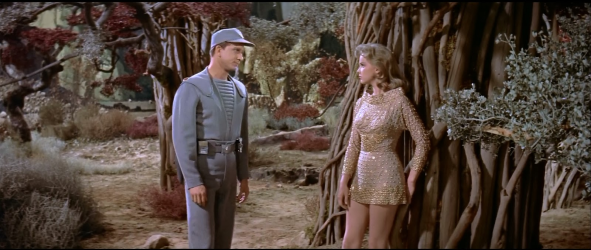
“So…uh…sublimate your id here often?”
…too late.
Well, turns out that they don’t have orders for what to do if everyone’s dead, so Captain and crew (including Jack “Bart Maverick” Kelley, Richard “Oscar Goldman” Anderson, Warren “That Guy From Forbidden Planet and the Star Trek Episode where they turn people into cubes” Stevens, George “Commando Cody” Wallace and Earl “I was in every episode of ‘Police Woman'” Holliman) start to build a transmitter to get a message back home.
While they didn’t, apparently, bring any kind of communication device with them that could reach Earth, they can manage to build one with the help of the one, the only, Robbie The Robot, star of greatest, most ’50s sci-fi movie poster of all time.
But before you can say “Based on William Shakespeare’s The Tempest“, equipment’s getting wrecked and crewmen are getting injured by a force that’s as unstoppable as it is huge and invisible.
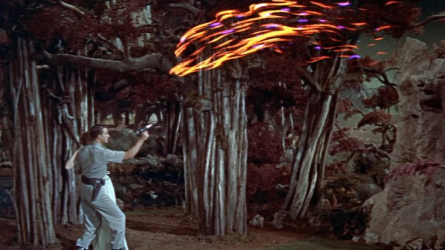
Huger, and more invisibler than this disintegrating tiger!
Maybe…just maybe…it has something to do with the ancient culture whose sole remnants are buried deep within the planet’s core.
Nah, that’s probably nothing. Forget I mentioned it.
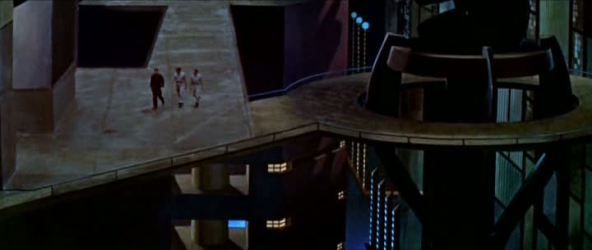
A society so advanced, they had SAFETY RAILS! (Unlike a certain Jedi empire.)
This is great pulp, right here. An engaging story, maybe a little too exposition-y for modern tastes at times, but not so much that you don’t get a lot of action, mystery, suspense and space bimbo. Its influence on “Star Trek” is apparent. The “music”, all electronic beeps and boops, is still pretty avant-garde. The effects are beautiful: The mattes, the models, the sets and costumes are the apotheosis of ’50s future. Robby is still implausible as the “one man” factory/wrecking crew/synthesizer—that is, you have to believe what they tell you about him rather than your own lying eyes, and that’s cool, man.

“Even though I can barely move my arms, I prepared this fine meal.”
Ann Francis is prototypical, archetypical and possibly the best to ever play the “what is a kiss?” role.
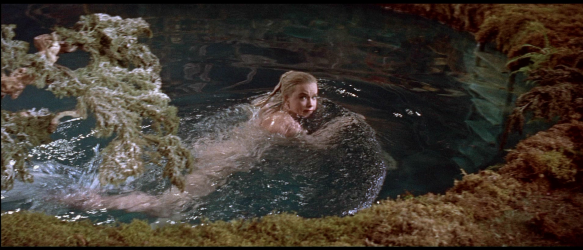
“What’s a swimsuit?” <–actual line from movie
More than that, it all works because, while the story is pretty far out, pushing the edges of Clarke’s third law, it’s all based around the premise of all great ’50s sci-fi: The USA would grow to take over the world, then all the planets in the solar system, then other worlds. Because America rocks! That such a premise seems farcical now tells you how far we’ve degraded in the 60 years since this came out.
Along related lines, the Bellerophon is run like a navy boat, which gives it a realism common to the day but gone in modern films. It makes sense, really: Military experience was common among them even if they had been on average 24.6 years old (unlikely) and thus too young to serve in the war, some kind of military experience was common. (Pidgeon was in WWI, Nielsen, Stevens and Kelly had stints in WWII but not in the Navy. Holliman lied about his age to join the Navy in WWII, so “Cook” may be informed by some firsthand experiences.)

By “Navy”, I mean “A bunch of people standing around watching other people work.”
In modern sci-fi, probably starting with Alien, ship crews tend to be slackers or ridiculous parodies of the military, as in Avatar, where Cameron has actual rednecks—like, plaid shirt-wearing, shotgun-toting bearded dudes—in the midst of his military briefings. The Freudian underpinnings (which I think are perhaps the silliest thing about the movie) carry the message of “Man can’t play God, and it’d be a bad idea if he could,” which is another interesting ’50s artifact: We can accomplish amazing things, but in a million years of technological advances, we will still be human.
MGM had dismantled its animation department, so the crew who put together the effects came from Walt Disney. If there’s a weakness, it’s that the monster, when revealed, looks a lot like a Disney monster. But it’s still pretty kick ass. You have to at least love the fact that they deliver on the beast.
If there’s a tragedy here, it’s that they didn’t shoot in technicolor. But the Eastman has held up okay especially because, while it wasn’t a big hit at the time, the movie became a classic quickly enough.
Well worth checking out. A must-see even.

Great review of a great movie!
The ship is the cruiser C-57D, and Morbius’s ship was the Bellerophon. And fans will fight you if you spell the robot’s name “Robbie.” It’s Robby, thank you very much!
Oh, wow, rooky [sic] mistake on my part!